Page 724 of 2100
5C±44
POWER±ASSISTED BRAKE SYSTEM
Removal
NOTE: If a squealing noise occurs from the rear brake
while driving, check the pad wear indicator plate. If the
indicator plate contacts the rotor, the disc pad assembly
should be replaced.
�Draw out two±thirds of the brake fluid from the
reservoir.
�Raise the vehicle and support it with suitable safety
stands.
1. Remove wheel and tire assembly, refer to
Wheels
and Tires System
in Section 3E.
2. Remove lock bolt (1)
306RW002
3. Rotate caliper assembly and support the caliper
assembly so that the brake hose is not stretched or
damaged.
4. Remove pad assembly with shim.
5. Remove clip.
Installation
1. Install clip (2).
306RW003
2. Apply special grease (approximately 0.2 g) to both
contacting surfaces of the inner shims. Wipe off
extruded grease after installing. Install pad assembly
with shim.
306RW004
Legend
(3) Inner Shim
(4) Wear Indicator
Page 725 of 2100
5C±45 POWER±ASSISTED BRAKE SYSTEM
306RW005
3. Carefyully use adjustable pliers to bottom the piston
into the caliper bore. Do not pull or twist the flex hose
or damage will occur.
302RS008
4. Install lock bolt (5) and tighten the bolt to the specified
torque.
Torque: 44 N´m (32 lb ft)
5. Install wheel and tire assembly, refer to
Wheels and
Tires System
in Section 3E.
6. Pump the brake pedal several times to make sure that
the pedal is firm. Check the brake fluid level in the
reservoir after pumping the brakes.
306RW006
Page 726 of 2100
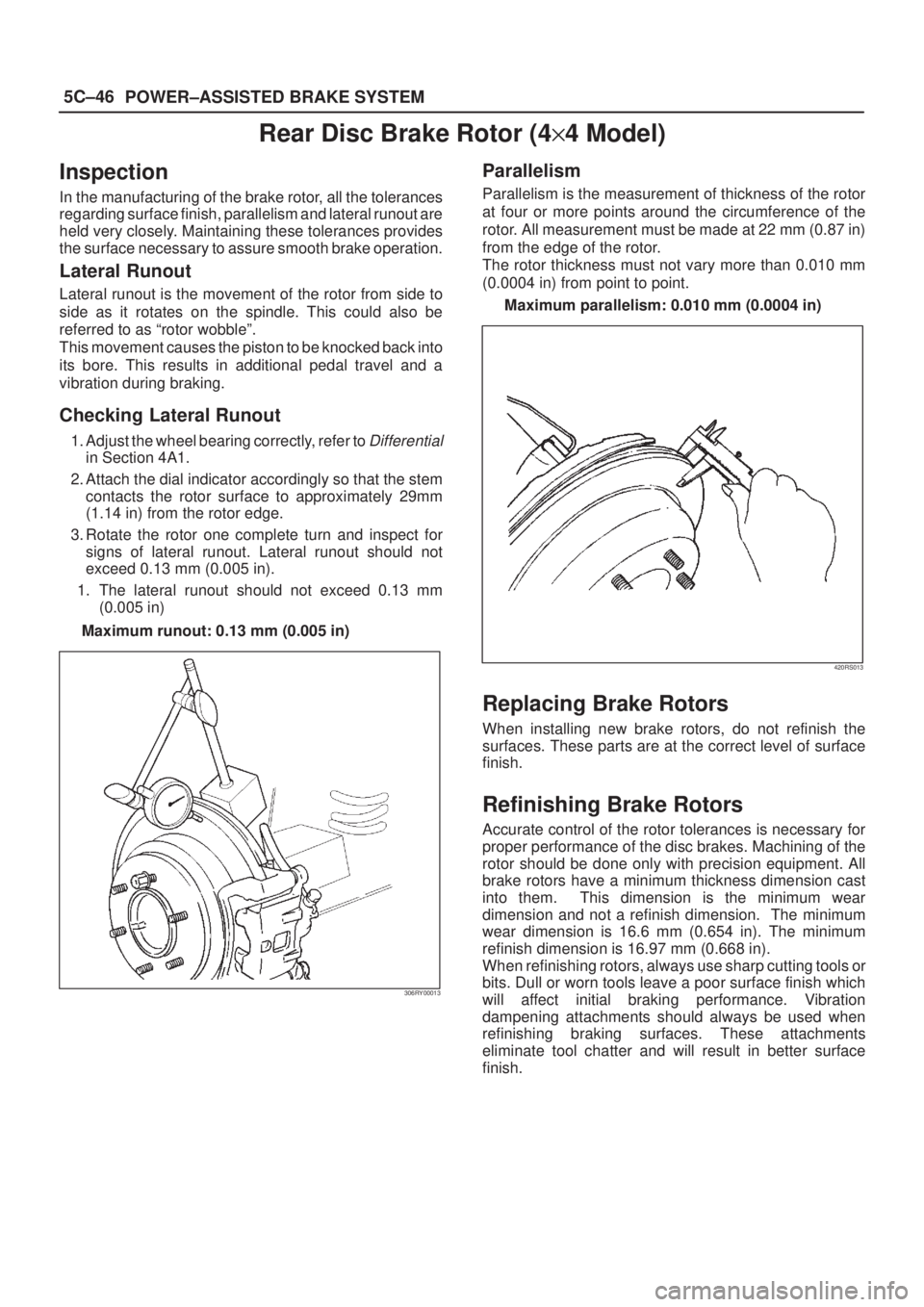
5C±46
POWER±ASSISTED BRAKE SYSTEM
Rear Disc Brake Rotor (4y4 Model)
Inspection
In the manufacturing of the brake rotor, all the tolerances
regarding surface finish, parallelism and lateral runout are
held very closely. Maintaining these tolerances provides
the surface necessary to assure smooth brake operation.
Lateral Runout
Lateral runout is the movement of the rotor from side to
side as it rotates on the spindle. This could also be
referred to as ªrotor wobbleº.
This movement causes the piston to be knocked back into
its bore. This results in additional pedal travel and a
vibration during braking.
Checking Lateral Runout
1. Adjust the wheel bearing correctly, refer to Differential
in Section 4A1.
2. Attach the dial indicator accordingly so that the stem
contacts the rotor surface to approximately 29mm
(1.14 in) from the rotor edge.
3. Rotate the rotor one complete turn and inspect for
signs of lateral runout. Lateral runout should not
exceed 0.13 mm (0.005 in).
1. The lateral runout should not exceed 0.13 mm
(0.005 in)
Maximum runout: 0.13 mm (0.005 in)
306RY00013
Parallelism
Parallelism is the measurement of thickness of the rotor
at four or more points around the circumference of the
rotor. All measurement must be made at 22 mm (0.87 in)
from the edge of the rotor.
The rotor thickness must not vary more than 0.010 mm
(0.0004 in) from point to point.
Maximum parallelism: 0.010 mm (0.0004 in)
420RS013
Replacing Brake Rotors
When installing new brake rotors, do not refinish the
surfaces. These parts are at the correct level of surface
finish.
Refinishing Brake Rotors
Accurate control of the rotor tolerances is necessary for
proper performance of the disc brakes. Machining of the
rotor should be done only with precision equipment. All
brake rotors have a minimum thickness dimension cast
into them. This dimension is the minimum wear
dimension and not a refinish dimension. The minimum
wear dimension is 16.6 mm (0.654 in). The minimum
refinish dimension is 16.97 mm (0.668 in).
When refinishing rotors, always use sharp cutting tools or
bits. Dull or worn tools leave a poor surface finish which
will affect initial braking performance. Vibration
dampening attachments should always be used when
refinishing braking surfaces. These attachments
eliminate tool chatter and will result in better surface
finish.
Page 728 of 2100
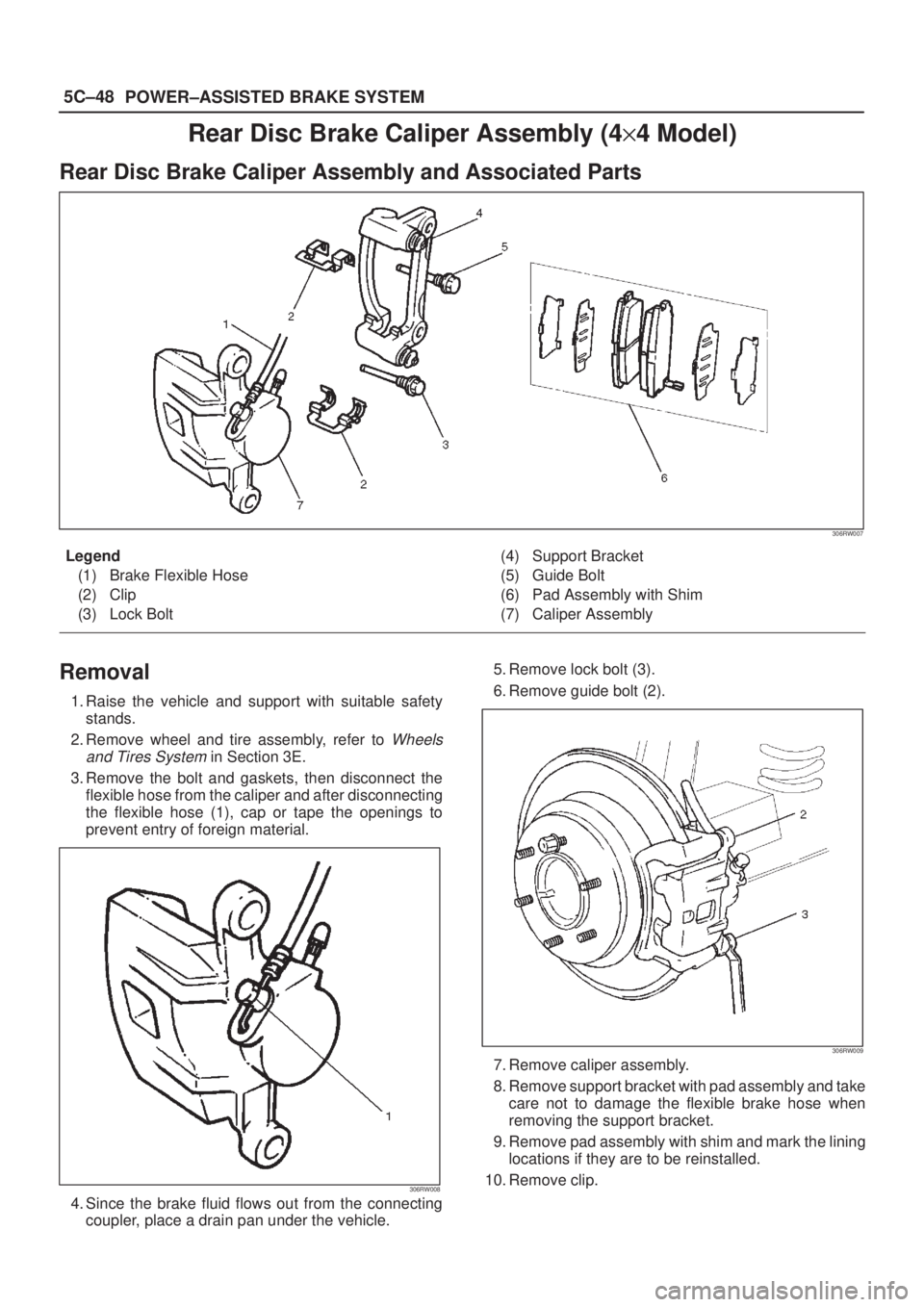
5C±48
POWER±ASSISTED BRAKE SYSTEM
Rear Disc Brake Caliper Assembly (4y4 Model)
Rear Disc Brake Caliper Assembly and Associated Parts
306RW007
Legend
(1) Brake Flexible Hose
(2) Clip
(3) Lock Bolt(4) Support Bracket
(5) Guide Bolt
(6) Pad Assembly with Shim
(7) Caliper Assembly
Removal
1. Raise the vehicle and support with suitable safety
stands.
2. Remove wheel and tire assembly, refer to
Wheels
and Tires System
in Section 3E.
3. Remove the bolt and gaskets, then disconnect the
flexible hose from the caliper and after disconnecting
the flexible hose (1), cap or tape the openings to
prevent entry of foreign material.
306RW008
4. Since the brake fluid flows out from the connecting
coupler, place a drain pan under the vehicle.5. Remove lock bolt (3).
6. Remove guide bolt (2).
306RW009
7. Remove caliper assembly.
8. Remove support bracket with pad assembly and take
care not to damage the flexible brake hose when
removing the support bracket.
9. Remove pad assembly with shim and mark the lining
locations if they are to be reinstalled.
10. Remove clip.
Page 730 of 2100
5C±50
POWER±ASSISTED BRAKE SYSTEM
302RW017
7. Install the wheel and tire assembly, refer to Wheels
and Tires System
in Section 3E.
8. Bleed brakes. Refer to
Hydraulic Brakes in this
section.
Rear Disc Brake Caliper (4y4 Model)
Rear Disc Brake Caliper Disassembled View
306RW014
Legend
(1) Guide Bolt
(2) Lock Bolt
(3) Bleeder with Cap
(4) Caliper Body(5) Piston Seal
(6) Piston
(7) Dust Boot: Piston
(8) Dust Boot Ring
(9) Dust Boot: Guide Bolt and Lock Bolt
Page 734 of 2100
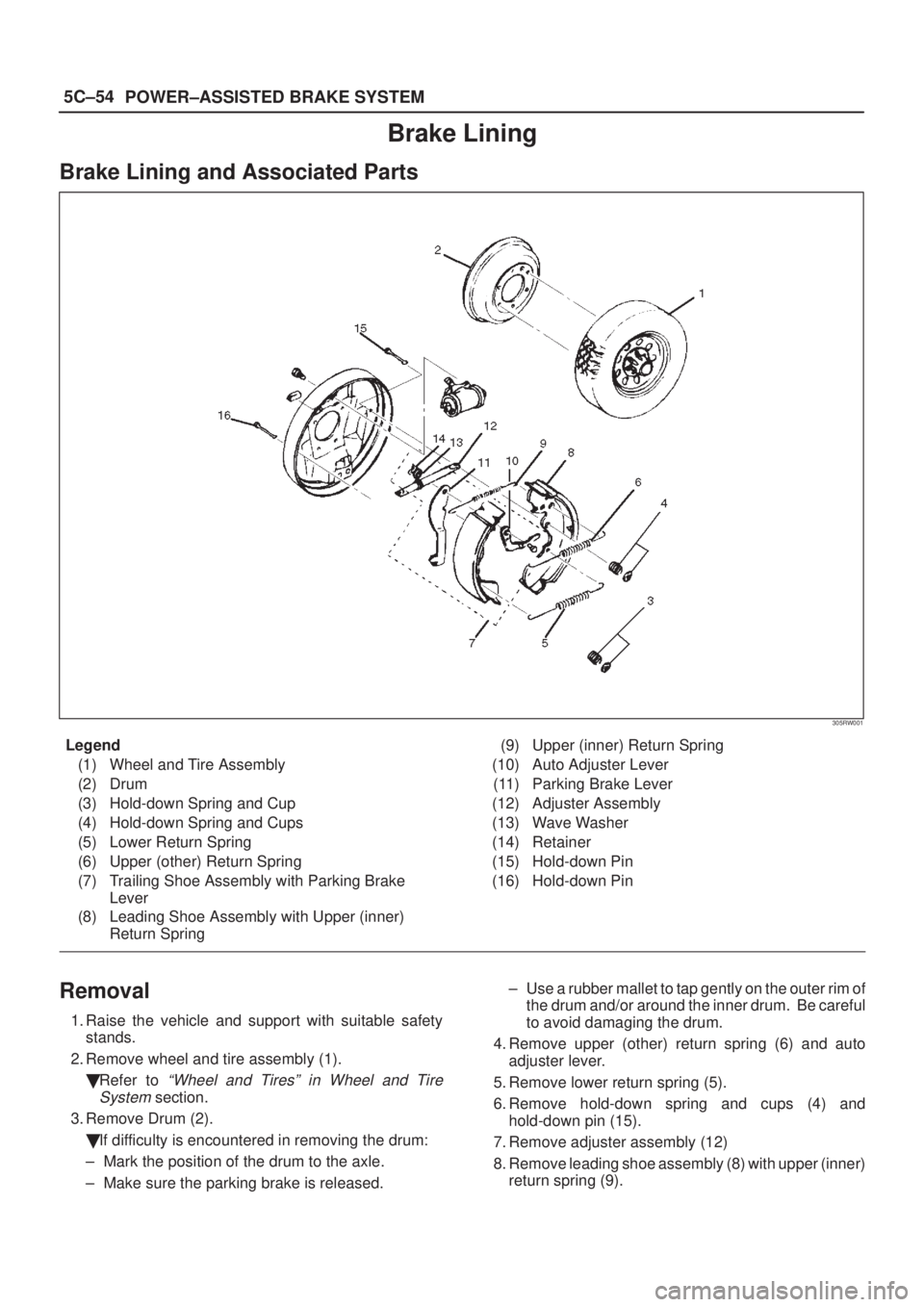
5C±54
POWER±ASSISTED BRAKE SYSTEM
Brake Lining
Brake Lining and Associated Parts
305RW001
Legend
(1) Wheel and Tire Assembly
(2) Drum
(3) Hold-down Spring and Cup
(4) Hold-down Spring and Cups
(5) Lower Return Spring
(6) Upper (other) Return Spring
(7) Trailing Shoe Assembly with Parking Brake
Lever
(8) Leading Shoe Assembly with Upper (inner)
Return Spring(9) Upper (inner) Return Spring
(10) Auto Adjuster Lever
(11) Parking Brake Lever
(12) Adjuster Assembly
(13) Wave Washer
(14) Retainer
(15) Hold-down Pin
(16) Hold-down Pin
Removal
1. Raise the vehicle and support with suitable safety
stands.
2. Remove wheel and tire assembly (1).
�Refer to
ªWheel and Tiresº in Wheel and Tire
System
section.
3. Remove Drum (2).
�If difficulty is encountered in removing the drum:
± Mark the position of the drum to the axle.
± Make sure the parking brake is released.± Use a rubber mallet to tap gently on the outer rim of
the drum and/or around the inner drum. Be careful
to avoid damaging the drum.
4. Remove upper (other) return spring (6) and auto
adjuster lever.
5. Remove lower return spring (5).
6. Remove hold-down spring and cups (4) and
hold-down pin (15).
7. Remove adjuster assembly (12)
8. Remove leading shoe assembly (8) with upper (inner)
return spring (9).
Page 736 of 2100
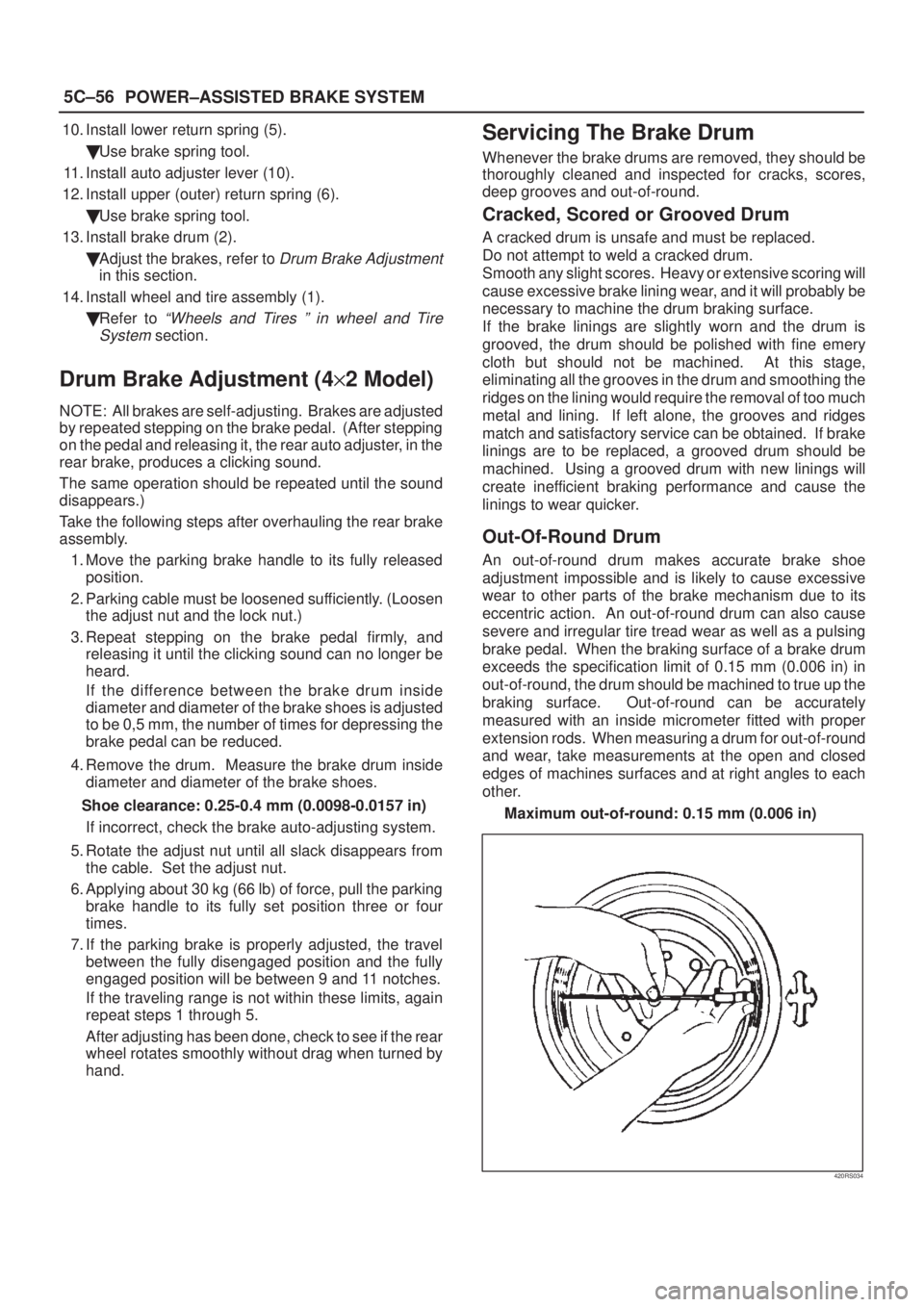
5C±56
POWER±ASSISTED BRAKE SYSTEM
10. Install lower return spring (5).
�Use brake spring tool.
11. Install auto adjuster lever (10).
12. Install upper (outer) return spring (6).
�Use brake spring tool.
13. Install brake drum (2).
�Adjust the brakes, refer to
Drum Brake Adjustment
in this section.
14. Install wheel and tire assembly (1).
�Refer to
ªWheels and Tires º in wheel and Tire
System
section.
Drum Brake Adjustment (4y2 Model)
NOTE: All brakes are self-adjusting. Brakes are adjusted
by repeated stepping on the brake pedal. (After stepping
on the pedal and releasing it, the rear auto adjuster, in the
rear brake, produces a clicking sound.
The same operation should be repeated until the sound
disappears.)
Take the following steps after overhauling the rear brake
assembly.
1. Move the parking brake handle to its fully released
position.
2. Parking cable must be loosened sufficiently. (Loosen
the adjust nut and the lock nut.)
3. Repeat stepping on the brake pedal firmly, and
releasing it until the clicking sound can no longer be
heard.
If the difference between the brake drum inside
diameter and diameter of the brake shoes is adjusted
to be 0,5 mm, the number of times for depressing the
brake pedal can be reduced.
4. Remove the drum. Measure the brake drum inside
diameter and diameter of the brake shoes.
Shoe clearance: 0.25-0.4 mm (0.0098-0.0157 in)
If incorrect, check the brake auto-adjusting system.
5. Rotate the adjust nut until all slack disappears from
the cable. Set the adjust nut.
6. Applying about 30 kg (66 lb) of force, pull the parking
brake handle to its fully set position three or four
times.
7. If the parking brake is properly adjusted, the travel
between the fully disengaged position and the fully
engaged position will be between 9 and 11 notches.
If the traveling range is not within these limits, again
repeat steps 1 through 5.
After adjusting has been done, check to see if the rear
wheel rotates smoothly without drag when turned by
hand.
Servicing The Brake Drum
Whenever the brake drums are removed, they should be
thoroughly cleaned and inspected for cracks, scores,
deep grooves and out-of-round.
Cracked, Scored or Grooved Drum
A cracked drum is unsafe and must be replaced.
Do not attempt to weld a cracked drum.
Smooth any slight scores. Heavy or extensive scoring will
cause excessive brake lining wear, and it will probably be
necessary to machine the drum braking surface.
If the brake linings are slightly worn and the drum is
grooved, the drum should be polished with fine emery
cloth but should not be machined. At this stage,
eliminating all the grooves in the drum and smoothing the
ridges on the lining would require the removal of too much
metal and lining. If left alone, the grooves and ridges
match and satisfactory service can be obtained. If brake
linings are to be replaced, a grooved drum should be
machined. Using a grooved drum with new linings will
create inefficient braking performance and cause the
linings to wear quicker.
Out-Of-Round Drum
An out-of-round drum makes accurate brake shoe
adjustment impossible and is likely to cause excessive
wear to other parts of the brake mechanism due to its
eccentric action. An out-of-round drum can also cause
severe and irregular tire tread wear as well as a pulsing
brake pedal. When the braking surface of a brake drum
exceeds the specification limit of 0.15 mm (0.006 in) in
out-of-round, the drum should be machined to true up the
braking surface. Out-of-round can be accurately
measured with an inside micrometer fitted with proper
extension rods. When measuring a drum for out-of-round
and wear, take measurements at the open and closed
edges of machines surfaces and at right angles to each
other.
Maximum out-of-round: 0.15 mm (0.006 in)
420RS034
Page 737 of 2100
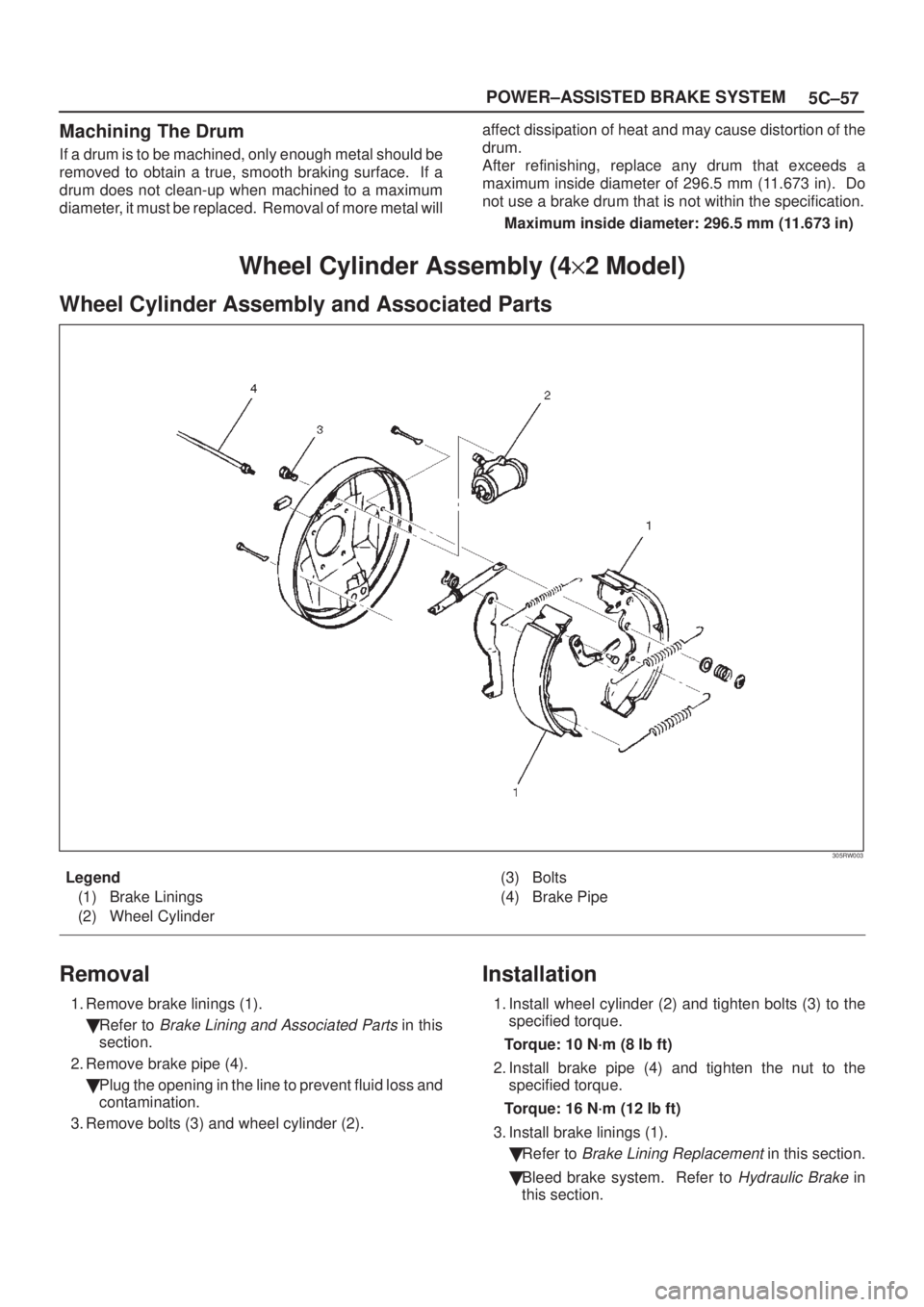
5C±57 POWER±ASSISTED BRAKE SYSTEM
Machining The Drum
If a drum is to be machined, only enough metal should be
removed to obtain a true, smooth braking surface. If a
drum does not clean-up when machined to a maximum
diameter, it must be replaced. Removal of more metal willaffect dissipation of heat and may cause distortion of the
drum.
After refinishing, replace any drum that exceeds a
maximum inside diameter of 296.5 mm (11.673 in). Do
not use a brake drum that is not within the specification.
Maximum inside diameter: 296.5 mm (11.673 in)
Wheel Cylinder Assembly (4y2 Model)
Wheel Cylinder Assembly and Associated Parts
305RW003
Legend
(1) Brake Linings
(2) Wheel Cylinder(3) Bolts
(4) Brake Pipe
Removal
1. Remove brake linings (1).
�Refer to
Brake Lining and Associated Parts in this
section.
2. Remove brake pipe (4).
�Plug the opening in the line to prevent fluid loss and
contamination.
3. Remove bolts (3) and wheel cylinder (2).
Installation
1. Install wheel cylinder (2) and tighten bolts (3) to the
specified torque.
Torque: 10 N´m (8 lb ft)
2. Install brake pipe (4) and tighten the nut to the
specified torque.
Torque: 16 N´m (12 lb ft)
3. Install brake linings (1).
�Refer to
Brake Lining Replacement in this section.
�Bleed brake system. Refer to
Hydraulic Brake in
this section.